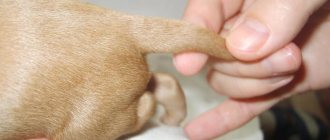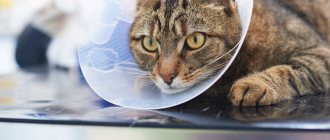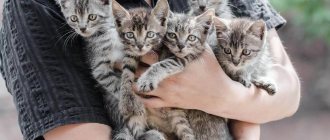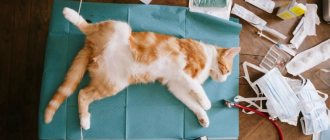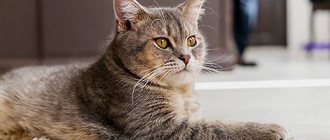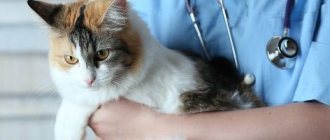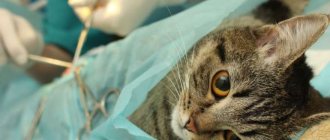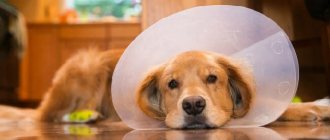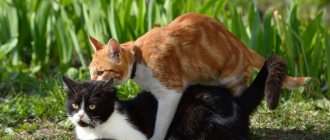Why is a British cat castrated and at what age? Surgery and subsequent care. Features of feeding castrated animals.
British cats have a bright appearance. They attract with their plush fur and large round eyes. Their sizes are larger than average - up to 8 kg, and the backbone is strong. The ears are straight, but with rounded tips, wide set. The muzzle is shortened and vaguely resembles a Persian.
The colors of British cats come in different colors. The most common are blue, patterned (tabby), gray. There are red and color-point cats. The white wool of the British looks interesting. Such individuals have blue eyes, and the coat is slightly thinner and softer.
The British have a majestic demeanor. They can be compared to English lords because of their poise and calmness. It is comfortable to live next to them in a house or apartment. They easily fit into any company of animals. They are trainable and very attached to their owner.
For the most part, British purebred cats have good health. However, they have a predisposition to diseases, so any manipulations and interventions require preparation.
Indications for castration
Sterilizing a cat is the best prevention of many dangerous diseases, including cancer. A sexually mature male needs partners for lovemaking every day, otherwise his health will begin to deteriorate. Usually, owners are not able to bring such a number of cats to their pet. In addition, an untied pet begins to behave badly, which not every owner can tolerate.
The Briton begins to leave fragrant marks on pieces of furniture and clothes of the owners, which should attract cats. In some cases, pets leave their waste products directly on the bed of the owner or his children. It is useless to punish the cat in this case - he just obeyed the call of nature. The pet will accompany its walk around its territory with a low, guttural meow. At what age should a British cat be neutered? It is better not to wait for the moment when the cat puts marks on all things in the house; they are very difficult to wash and most of the clothes and household items will have to be thrown away.
Favorable age for castration
Veterinarians recommend performing the operation before the animal reaches puberty. At what age should a British cat be neutered? The decision is made by the owners after consulting a doctor. Surgery is usually scheduled between 7 and 12 months of age. During this period, cats are already stronger and they usually do not experience complications.
Of course, you can castrate your pet later; some doctors even take care of older animals. But if a cat has been marking in the house for several years and has already formed a habit, then in some cases he continues to do this even after surgery. Castration is a simple operation and owners should not be afraid of it. The procedure itself will take no more than 30 minutes. Within a few hours, the cat will recover from anesthesia, and after a couple of weeks it will not even remember about the trip to the clinic.
Methods for sterilizing a cat
There are three main methods of performing surgery to remove the genital organs of a cat:
Classic (along the white line). An incision ranging from one and a half to five centimeters in length is made in the central part of the abdomen below the navel. The peritoneal wall is incised between the muscles. After the uterus and ovaries are removed, the blood vessels are ligated with surgical absorbable suture. Sutures are placed on the peritoneal wall and skin. If no absorbable suture was used to place the stitches, they will need to be removed after two weeks. During this time, the animal must wear a medical blanket to protect the suture from infection.
Side cut. This method does not require complex postoperative care for sutures. It is used to sterilize stray cats, which are released into the wild immediately after surgery. Most often, only the ovaries are removed using this method.
The laparoscopic method is named after the instrument used for the operation. A laparoscope is a device for penetrating body cavities without traumatic damage to external tissues. To insert it into the body, you only need a tiny incision. The laparoscope is equipped with a video camera that helps the surgeon monitor the progress of the operation. To increase visibility during manipulations, the abdominal cavity is filled with carbon dioxide. The ovaries and uterus are removed through a small hole.
The advantages of this method include:
- practically painless;
- access to the abdominal cavity through a small puncture causes minimal tissue trauma;
- visual control at all stages of the operation;
- there is no possibility of infection;
- no postoperative care is required.
Any of the surgical methods requires the use of general anesthesia.
Postoperative sutures in cats
After sterilization, a suture is placed on the incision. When suturing the peritoneal wall, use catgut or synthetic absorbable threads. Postoperative care of the suture consists of periodic treatment with a disinfectant.
Classification of seams:
- The classic knot is reliable, but not flawless from an aesthetic point of view. Designed for a yard cat for which it is impossible to provide full supervision. Since she will try to remove the seam with her tongue, maximum strength is needed.
- Continuous interrupted skin suture - the doctor removes it 10 days after surgery. It does not cause too much damage to the skin and resolves after a few months.
- A continuous intradermal suture does not require removal. It is performed with a thread that will resolve (completely heal) a couple of months after the operation.
Preparing for castration
Before the procedure, owners should meet with the veterinarian who will operate on the cat. Although castration is not complicated, it is still performed under anesthesia. If the pet has a history of food allergies or drug intolerance, owners should tell their doctor about it. At what age should a British cat be neutered? The veterinarian will be able to help determine this issue.
Sometimes the doctor may order tests or recommend an ultrasound examination. This advice should not be neglected, since the cat must be absolutely healthy before surgery. If before castration the pet becomes lethargic or refuses to eat, the procedure should be rescheduled. On the day of surgery, the cat should not be fed; it is advisable that he empties his bladder before going to the clinic.
Anesthesia
Castration of a cat lasts no more than five minutes. However, for humane reasons, any surgical intervention is performed using anesthesia. Surgeries are not performed without general anesthesia.
Types of pain relief:
- non-inhalation;
- inhalation;
- local anesthesia
The listed methods are often used in combination.
Non-inhalational anesthesia. This type of pain relief is used most often. To achieve the effect, a combination of medications that inhibit pain sensitivity (ketamine) and muscle relaxants (xyl, meditin, etc.) is used. The duration and depth of the anesthetic effect depends on the dosage of medications and is calculated depending on the weight of the animal. This type of pain relief is used in clinics and when performing surgery at home.
Representatives of breeds predisposed to cardiac pathologies undergo a preliminary examination. This applies to the Don Sphynx, Kuril Bobtail, British Shorthair and Scottish cat breeds.
Inhalation anesthesia. A gas mixture of anesthetics (isoflurane, fluorothane, cyclopropane, nitrous oxide) is supplied to the animal’s respiratory system. This method is considered the least dangerous in veterinary medicine, since the medications enter and exit naturally. The intensity of drug administration is controlled by the cat’s body itself: when breathing is suppressed, the process is inhibited, reducing the dose of the substance entering the lungs. The kidneys are not involved in the process, so it can be used for older individuals. The disadvantage of this method is the need for inhalation equipment and high cost.
Local anesthesia. Novocaine or lidocaine is injected under the skin (into the spinal cord) of the cat. The method is rarely used, since the animal remains conscious, actively resisting the surgeon.
Combined anesthesia. For our little brothers, any anesthesia is a complex (scheme) of several methods. To prevent the patient from resisting the manipulations, he must first be put to sleep or his muscle reflexes inhibited.
Blanket on a short-haired cat
Castration
It is better to carry out the operation in a clinic, since it is impossible to achieve sterility at home. Also, in case of complications, without additional drugs and tools, the cat may simply not be saved in time. In the event of cardiac arrest, the minutes count; the animal will not have time to be transported to the clinic for resuscitation.
The operation takes no more than 30 minutes, but usually the doctor finishes faster. The British man's testicles are removed and a ligature is applied. In some clinics, after surgery, cats are given a drug that supports heart function. Then the pet is given to the owners. Most likely, the cat will still be unconscious at this moment, but he will soon come to his senses. Usually it takes no more than 2 days to fully recover from anesthesia. At what age can a British cat be neutered? Doctors recommend doing this no later than 7 years.
Operation
The castration procedure itself is quite simple, not expensive and usually takes about 10 minutes:
- The anesthesia is given - quite light, compared to what may be needed during abdominal operations and more serious surgical interventions.
- An incision is made in the scrotum area through which the testicles are removed.
- At the end of the operation, the incision is sutured. Externally, the operation site becomes completely invisible; you can understand that the testicles have been removed only by touch.
Postoperative care
The veterinarian often gives owners eye drops. The thing is that cats under anesthesia do not blink and because of this their mucous membranes dry out. Therefore, every 30–60 minutes, owners should put drops in their pet’s eyes.
Arriving home, you need to put the Briton on a mat. Do not place it on a hill, for example, on a chair. When recovering from anesthesia, cats are clumsy and can get injured. Monitor the temperature of the paw pads and, if necessary, rub them without strong pressure, this will improve blood circulation in the limbs.
At what age are British male cats castrated? It all depends on the pet’s health condition. It will be better if it is not too hot or cold on the day of castration. After the cat has recovered from anesthesia, you need to offer him water. It is prohibited to force liquid in, as the Briton may choke. The next day you can feed him special canned cat food or chicken broth.
TOP 12: RANKING OF THE BEST FOOD FOR BRITISH CATS
Food rating for the British:
- Orijen – 80% protein, 20% vegetables and fruits
- Acana – 70% protein, 30% vegetables and fruits
- Wildfield – 60% protein, 40% vegetables and fruits
- Farmina – grain-free food + probiotics, medicinal herbs
- Trainer – food for animals with sensitive digestion, kidney problems, etc. These foods help maintain health. Suitable for animals with gluten intolerance. Products for processing into feed are steamed.
- Science Plan (Hills) is a good food for everyday nutrition, well digestible, does not cause allergies, natural antioxidants and preservatives, a wide range of feeds, excellent distribution.
- Bosch cellulose and maize additives are harmful and can cause allergies.
- OK Passion – not suitable for sensitive cats
- Purina ProPlan - high in protein, rice is used as a cereal, but wheat flour is still added. Probiotics.
- Royal Canin (Royal Canin) - there is an everyday line and a medicinal one. Everyday series - a lot of preservatives (the Russian line of food is not recommended, it is better to give preference to the French one). The medicinal series is perfectly balanced and has good reviews from veterinarians and has a healing effect.
- Premil – additives and flavor enhancers. No gluten.
- Josera - Overall a good food, it rarely causes allergies, it contains corn gluten.
*All these foods contain minerals, vitamins, and beneficial additives.
Take proper care of your pets and choose the best food for them!
Early castration
Some animals go through puberty very quickly. At what age is it better to castrate British cats? Doctors do not have a consensus. Veterinarians agree on only one thing - it is not worth delaying the operation for up to 5-7 years.
In European countries, it is now customary to castrate cats when they reach two months of age. During this period, tissues have maximum ability to regenerate. Also at this age, after castration, a so-called biological node is formed, which allows you to avoid applying a ligature. After early castration, the likelihood of bleeding and other complications is minimal. The only disadvantage of this procedure is the fact that it is difficult to determine the breeding value of a small kitten. But if the kitten will definitely not be used for breeding, then breeders prefer early sterilization.
When and why do they castrate?
Britons, like other breeds, are neutered for a variety of reasons. This could be due to excessive aggression, noise, bad behavior of the animal, or the owners do it for medical reasons.
Another reason why many owners bring their pets to the clinic is the appearance of unwanted offspring. You need to be responsible for the animal and understand that its walk may lead to the birth of homeless kittens.
Despite all the recommendations on the optimal age for castration of an animal, the decision about when to perform the operation remains with the owner. To decide on the time, you need to familiarize yourself with all the advantages of early and late castration.
Early castration is the infertility of a kitten in the second month of life. One of the advantages is that the organs and tissues of the animal are still tender. This is the best time to castrate a cat for biological purposes.
At such a young age, the likelihood of bleeding and other complications is minimal. The occurrence of a painful effect in such cases is practically not observed. In most cases, the kitten returns to normal within a few hours after the operation and runs around the house, although you should not allow it to do this.
But there are negative aspects to early castration. An unpleasant consequence may be slow development of the body. Gaining muscle mass depends on the level of sex hormones in the blood, but after removal of the testes, their production stops. Early sterilization leads to the fact that even in the fifth year of life the cat looks more like a kitten than an adult animal. Also, early intervention threatens the appearance of problems with the heart and joints.
A cat can be neutered in adulthood, but late sterilization does not have many advantages. It is easier to operate on already formed tissues and organs, but this is the only advantage of this procedure. The development of the animal for a long time took place with the participation of sex hormones, so the character of the cat and its habits were formed partly under their influence, and after castration the pet can change beyond recognition. In addition, sutures on hard tissues are placed worse and the likelihood of internal bleeding is quite high.
After late castration, the animal owner needs to prepare for a complete change in the cat’s diet, because the metabolism will be slowed down by 25%. Otherwise, the pet will develop problems with excess weight.
Adult cats have a lower pain threshold than kittens, so the likelihood of pain shock is higher.
Late castration
Such sterilization is considered if the cat being operated on is more than 2–3 years old. The only advantage of such an operation is the fact that the organs have already formed and it will be easier for the doctor to perform the operation. At what age should a British cat be neutered? It is better to perform the operation before the pet is 1.5–2 years old.
The risk of complications begins to increase sharply if the cat being operated on is 7 years old or older. In this case, it is necessary to check the heart before castration. In addition, older cats' metabolism begins to slow down much faster, which leads to obesity and deterioration of health.
Natural nutrition at home
A proper home diet consists of half meat. The cat is a carnivore, so meat forms the basis of its menu. Choose lean meat: turkey, chicken, beef, veal. Be sure to supplement meat products with plant foods. Porridge (buckwheat, oatmeal, rice), legumes, pureed fresh vegetables, add chopped fruit are useful. It is optimal to include liver in the menu once a week.
To ensure that your four-legged pet receives more vitamins, let him eat fresh grass. Constipation is typical for British operated cats and cats, so you need to give them cottage cheese, kefir, fermented baked milk, and vegetables. Your pet needs to cook separately and always make sure the food is fresh. Cooking homemade food is a rather labor-intensive task that requires time, effort, and discipline. Therefore, think carefully, maybe you should use industrial food.
What not to feed a British cat
At home, you cannot feed a castrated British cat homemade food containing spices, salt, and sugar. List of products prohibited for operated animals:
- fish, seafood;
- smoked, salted, fried, spicy dishes;
- fat meat;
- sweets;
- semi-finished products;
- bakery.
Sweets, baked goods, and flour foods lead to diabetes and obesity; other foods cause kidney and gastrointestinal diseases.
Magnesium, which is contained in fish and seafood, leads to the formation of stones, so fish is contraindicated for neutered British cats.
Rules for feeding at home
To help the British body cope with stress, switch your pet to a new food in advance, gradually accustoming it to the new diet. Avoid overeating in your pet.
Feed your pet strictly according to the clock, do not allow snacks between meals
Cats often start begging for food or try to steal it, so be persistent. Watch your caloric intake. After the operation, the animal becomes lazy, moves little, needs less energy, and the habit of eating a lot remains. An approximate portion of a five-kilogram British cat should be 160 - 300 g of natural food.
Possible complications
The risks of surgery increase if the animal is elderly. At what age should a British cat be neutered? It is better not to delay this procedure, since older pets take much longer to recover from surgery than young ones.
We must not forget that using anesthesia is always a risk. Surgeries are especially dangerous for cats suffering from heart failure. After castration, the animal may bleed and the wound may become infected. Active cats sometimes have sutures that come apart.
Feeding a neutered cat
The portion size for a British castrated cat should be reduced by 25%, because after castration the metabolism deteriorates. You should not give your cat fish, because salts and minerals begin to be absorbed worse. It is important to feed your pet only specialized food for cats after castration. It is necessary to give food more often, but in small quantities. The animal should always have access to water.
All information posted on the site is provided in accordance with the User Agreement and is not a direct instruction to action. We strongly recommend that before using any product, you must obtain a face-to-face consultation at an accredited veterinary clinic.
Breed characteristics
Sometimes owners at a veterinary clinic ask the question: “At what age should a British Fold cat be neutered?” First of all, the doctor usually explains that such a breed simply does not exist. Only the Scots have lop ears, the British do not. This confusion is due to the fact that many years ago interbreed matings were allowed, which are now prohibited. It was then that people had the wrong opinion about the British, although they have standard ears, the same as all ordinary cats.
Appearance
The British cat is distinguished by its plush fur and large, round amber eyes . These cats have well-built, strong muscles, so on average their weight reaches 8 kg. Their ears are straight and set wide apart, with slightly rounded tips.
Unlike a Scotsman, whose ears are slightly curved forward, a British breed cat does not have such a distinctive feature, so you should not buy kittens from those who will convince you otherwise.
The face of the British cat is slightly reminiscent of the Persian breed and has a somewhat shortened appearance. Their coat color is predominantly gray or blue; British tabbies, which have a characteristic contrasting pattern on their coat, are less common. Color-point and ginger cats can also be found. It is no less surprising to look at a British dog with white fur and blue eyes, but this can also happen.
